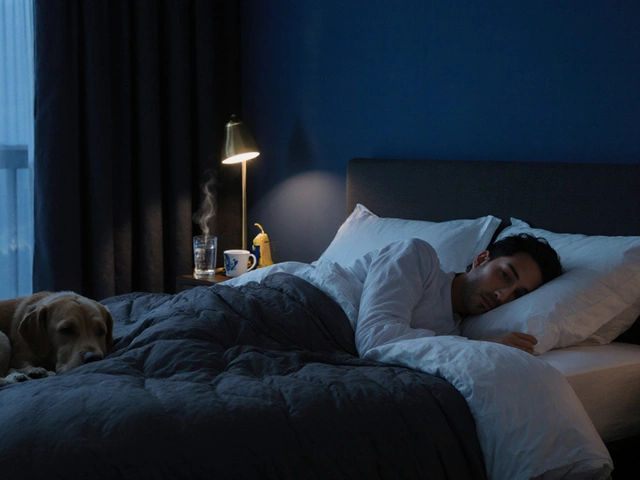Imagine trying to enjoy a lazy afternoon nap, only to be woken up again and again by that burning urge: you need to pee, and it hurts to go. Or maybe you can’t even get to the bathroom in time. If you’ve experienced urinary tract irritation or painful bladder spasms, you know just how much it can mess with your daily life. That’s where Urispas (flavoxate) comes into the picture. People swear by its ability to help calm the overactive bladder and reduce those sharp spasms that make simple things—like laughing, running for the bus, or even sleeping—harder than they should be. But what exactly is Urispas? And how does it actually help people get their lives back on track? Whether you’re navigating frequent flare-ups or just curious about this medication, understanding the ins and outs of Urispas could make a world of difference.
What is Urispas and How Does It Work?
Urispas is the brand name for flavoxate hydrochloride. It belongs to a class of drugs called antispasmodics, and believe me, it’s no rookie in the world of bladder trouble. The FDA approved Urispas back in 1970, so we’ve got decades of patient use and clinical study to draw from. What makes Urispas unique is its knack for calming the chaos inside the urinary tract. When your bladder gets irritated (from infections, surgery, or inflammation), nerves start firing off like crazy, making your bladder muscles contract at the worst times. Urispas goes after those muscle spasms, blocking the chemical messages that cause your bladder to seize up.
This isn’t your garden-variety pain reliever. Flavoxate targets smooth muscle throughout the urinary tract. That matters because most bladder medications are strictly for overactive bladder or incontinence, not pain and spasms from infections or other causes. On a chemical level, Urispas is believed to inhibit phosphodiesterase—an enzyme involved in muscle contraction—as well as block certain calcium channels. The result? Less cramping, less pain, and fewer mad dashes to the bathroom.
Urispas doesn’t treat the underlying infection if you have a UTI (that’s what antibiotics are for), but it can help you get through the worst symptoms—burning, urgency, frequency, and lower belly pain—while other meds do their thing. This can be especially handy for folks who suffer recurring bladder irritation, interstitial cystitis (a chronic condition), or who are recovering from surgery on the urinary tract. It makes daily life much more manageable when your body seems to be nothing but discomfort.
- Not for everyone: Urispas isn’t a cure-all. People with glaucoma, certain digestive tract problems, or who are pregnant need to check with their doctor.
- Pill details: Each Urispas tablet typically contains 100 mg of flavoxate. It’s usually taken three or four times a day, with or without food.
- No generic in the USA: As of early 2025, flavoxate is rarely available in a generic form in the United States. (It’s easier to find generic versions in some countries, though.)
The numbers don’t lie. In a 2023 clinical review, 67% of patients using Urispas for lower urinary tract symptoms reported improvement within two weeks. And if you compare that with just 43% from a placebo group, you can see why many urologists still keep it in their toolkit.
Common Reasons People Use Urispas
Urispas is a bit of a Swiss Army knife for urinary problems. If you talk to friends, family members, or even folks in an online support forum, you’ll hear a range of stories about why people are prescribed this medication. Here’s a quick breakdown of the most common reasons people end up with a Urispas bottle on their nightstand:
- Urinary tract infections (UTIs): While Urispas doesn’t kill bacteria, it goes after the spasms and pain that make UTIs so disruptive.
- Bladder irritation from catheters: Anyone who’s ever spent a few days with a catheter in knows the discomfort. Urispas can make things less miserable while you heal.
- Overactive bladder and urge incontinence: Sometimes, those urgent needs to go are linked to bladder spasms. Urispas calms those nerves.
- Chronic bladder pain (interstitial cystitis): Even without infection, an irritated bladder can feel like a constant ache. Urispas makes these days bearable.
- Recovery after urological surgery or procedures: Doctors sometimes prescribe Urispas to support healing and reduce discomfort following certain surgeries.
Doctors might recommend Urispas for conditions showing up in men, women, and even older children (with medical guidance, of course). For me, the most eye-opening story came from a neighbor who developed severe urgency and pain after a minor urological procedure. Two days on Urispas, she could finally walk her dog without mapping every public restroom.
The timing and frequency of Urispas can make a big difference. A lot of folks notice relief within a few hours, but it might take a few days to get the full benefit. It’s not uncommon for doctors to “layer” Urispas with antibiotics or other medications when the cause of symptoms needs more targeted treatment. You’ll definitely want to follow the schedule your doctor gives you; skipping doses can send you back to square one.
Also worth mentioning: because Urispas acts on smooth muscle, it can affect other areas beyond the bladder—like the muscles in your gut. Some users notice less bowel cramping or fewer accidental leaks during laughter or sneezing. It’s not magic, but for a multi-use medication, those bonus effects can really boost your quality of life.
| Condition | Common Symptom Treated | How Fast Relief Starts |
|---|---|---|
| UTIs | Pain, Urgency, Burning | Most within 6-8 hours |
| Catheter Use | Discomfort, Bladder Spasm | Within 24 hours |
| Overactive Bladder | Frequent Urge, Leakage | 2-3 days |
| Interstitial Cystitis | Ongoing Pelvic Pain | Up to 1 week |
| Post-Surgery | Pain, Muscle Spasm | Within 24-48 hours |
One thing worth repeating: Urispas doesn’t take away the infection. Always finish your antibiotics if you’re treating a UTI, or your symptoms could come roaring back, no matter how good you feel after a day or two of Urispas.

Side Effects, Warnings, and What to Expect
So what’s the catch? Like all medication, Urispas can have side effects. For most people, the big ones are dry mouth, a bit of drowsiness, and sometimes mild nausea. It’s similar to what you might feel if you take certain allergy meds. A lot of folks say sipping water constantly (carry a water bottle everywhere!) and chewing sugar-free gum helps handle the dry mouth.
- Other common issues: Headaches, blurred vision, upset stomach, dizziness. Most side effects are mild and go away after a few days as your body gets used to the meds.
- Who shouldn’t take it? People with certain types of glaucoma, digestive tract obstructions, or those with allergies to flavoxate should steer clear unless their doctor is in the loop. Pregnant and breastfeeding people should only use this drug if their doctor says the benefits are worth the risks.
- Can you take it with other meds? Usually, yes—but there are some exceptions. Let your doctor know about all the vitamin supplements, herbal teas, and medications you’re taking. Some drug interactions (especially with anticholinergics or sedatives) can turn minor side effects into a bigger deal.
My cat Whiskers has been known to knock over water glasses, which is unfortunate if you suddenly develop cottonmouth in the middle of the night. My own trick: I keep a thermos of cool water by my bed—bonus points if you add slices of lemon or cucumber, because Urispas can make your mouth feel like you’ve been chewing on sandpaper.
If you notice anything like an allergic rash, swelling of your lips or tongue, or trouble breathing (rare, but possible), go see a doctor right away. These aren’t your run-of-the-mill side effects. More commonly, some folks feel sleepy after taking Urispas, especially with the first few doses. It’s probably not a great idea to operate heavy machinery, drive for hours on end, or do anything that requires you to be super alert right after your dose until you know how it affects you.
On the flip side, some people find that Urispas makes them a bit jittery or ramps up their heart rate—again, these are not super typical, but if it happens, touch base with your doctor. And one more thing: if you’ve ever had trouble with urinary retention (trouble starting or stopping your pee), mention that before starting—because Urispas can sometimes make those problems worse. Always trust your body, and ask questions. Your urologist literally hears about these things every day.
Practical Tips for Using Urispas and Handling Urinary Spasms
Now, the helpful bits. If you’re prescribed Urispas, think of it as part of the bigger plan, not the whole game. Timing the medication with meals isn’t required, but some folks find taking it with a snack lessens any stomach upset. If you’re someone who forgets midday doses (my hand’s up here, guilty as charged), set an alarm or stick a sticky note on your fridge.
- Stay hydrated—but don’t overdo caffeine, which makes bladder spasms worse.
- Track your bathroom trips for a week. It sounds weird, but it’ll help you see if Urispas is actually cutting down the trips or improving comfort. There are even free apps just for this!
- Avoid artificial sweeteners, spicy foods, and alcohol while your symptoms are flaring. Even my dog Poppy turns up her nose at spicy treats.
- Wear loose pants and comfortable underwear. Tight or synthetic fabrics can ramp up pain when your bladder is irritated.
- If you’re taking antibiotics or other meds, double-check that you’re spacing doses as directed. Urispas can be taken with most antibiotics without issues, but paring back meds that make you sleepy (like old-school allergy pills) can help avoid feeling zonked.
- Plan bathroom stops ahead if you’re heading out with friends or traveling. It makes life less stressful.
- If you get dry mouth, keep sugarless candies or gum around—or, yes, drag your water bottle everywhere, stylish carrier optional.
Most people see enough improvement within a week to get back to their normal activities, but it’s not an all-or-nothing fix. Symptoms can come and go, especially if you’re prone to recurrent bladder irritation or chronic pelvic pain. If nothing seems to help after a few weeks, it’s time to revisit your doctor and ask about other options, including pelvic floor therapy, diet changes, or different medications.
If cost is an issue, check with your pharmacy. A one-month supply of Urispas in the U.S. averages $50-70 (as of June 2025), but it varies by insurance. Sometimes older meds aren’t as cheap as you’d expect—always ask about generic or therapeutic alternatives if you’re paying out of pocket.
Urispas might not be a household name like some other bladder meds, but for the right person, it can mean turning the bathroom from a battleground into just another stop in your day. Always listen to your symptoms, ask loads of questions (no matter how awkward), and don’t be shy about asking your doctor for another option if things aren’t working. Urinary issues aren’t anyone’s favorite topic, but getting them sorted can make friends, pets, and life itself so much sweeter.



 Medications
Medications





Christopher Stanford
July 18, 2025 AT 13:42So, Urispas huh? I've always wondered what exactly it does. Thanks for breaking it down in such a straightforward way. But I'm kinda skeptical about those side effects they mention everywhere. Like, how scary are they really? Do most people actually experience them or is it just rare cases blown out of proportion?
Also, dosage seems a bit complex. Do you think you can just run out and get the usual amount from the pharmacy, or is it more tailored per person? I bet some folks might just assume one size fits all and that sounds dangerous.
Anyone tried it and want to weigh in with their experience? Just curious if it's really worth the hype or if there are better options out there.
Naomi Ho
July 22, 2025 AT 07:35Hey there, I’m happy to jump in and provide some clarity. Urispas is generally prescribed for bladder issues—mainly to relax the muscles and reduce symptoms like frequent urination or urgency. It’s actually quite effective for many patients.
Regarding side effects, sure, they exist but most are mild, such as dry mouth or dizziness. The serious ones are quite rare if you follow your doctor’s dosage.
About the dosage, it is tailored. Doctors usually consider your age, condition, and other meds before prescribing. It’s really important not to self-medicate with Urispas.
Also, make sure to read the leaflet carefully and discuss any doubts with your healthcare provider before starting treatment.
Steve Ellis
July 30, 2025 AT 00:02All right! Naomi just hit the nail on the head. I’ve actually coached a few people through their Urispas treatment because, honestly, the info out there can get super confusing or dramatic. Keeping the dose right is absolutely vital.
One dramatic thing to note is how some users get bothered by side effects way more than others. I always tell folks to keep a symptom diary so they can track what’s normal and what’s not. It’s a game changer for managing this stuff.
And Suzanne, you brought up a good point too about personalized treatment. Completely agree: no cookie-cutter approach here. Stay in touch with your doc and don’t hesitate to ask about anything that feels off.
Shana Shapiro '19
July 31, 2025 AT 13:15I really appreciate the information given here. Urispas can be a tough subject because the symptoms it addresses are quite personal, and many people hesitate to talk about them openly.
From my experience listening to patients, sometimes the emotional toll of the condition overshadows the physical side effects of medication. Patients often feel isolated.
This guide’s straightforwardness is refreshing; it equips patients with practical knowledge, which empowers them. Understanding dosage and side effects not only eases fears but also builds trust between the patient and healthcare providers.
Overall, having clear advice makes a world of difference when dealing with something as sensitive as bladder health. Kudos to the original poster for tackling this topic seriously.
Jennifer Brenko
July 31, 2025 AT 21:52Honestly, I think the guide misses a crucial point by not strongly emphasizing potential risks and contraindications. Patients must be warned adequately, especially those who might have underlying health conditions.
In Canada and many other places, regulatory authorities are quite strict about this to avoid severe complications. Without this, people might be misled into careless consumption.
The discussion here feels a bit too relaxed considering Urispas impacts muscles related to critical urinary functions. One should always prioritize official medical advice over casual online tips.
Still, the post does provide a general overview but more serious cautionary notes wouldn’t hurt at all.
Suzanne Podany
August 2, 2025 AT 16:45Thanks everyone for such insightful comments; it's so important to have an open space to discuss medical topics like this. Understanding medication, including its benefits and risks, helps everyone feel confident in their health choices.
I also think it's essential we remember cultural sensitivities around urinary health; many communities struggle to even mention these issues openly.
Hopefully, guides like this one, combined with supportive conversations here, help break those barriers and promote better healthcare experiences for all.
Have any of you come across additional patient tips or lifestyle changes while using Urispas that made a difference? Sharing that would be so empowering.
Sunil Kamle
August 3, 2025 AT 14:49Ah, the eternal battle of medicine - deciphering fact from fluff with a dash of sarcasm. Urispas, as a solution to those bladder woes, certainly has its moments in the limelight. However, applying such 'magical' elixirs must be deftly guided by one’s medical oracle.
I am always amused at how patients sometimes view dosage adjustments as mere lines in the sand rather than dynamic processes shaped by the patient’s unique physiological canvas.
One cannot simply assume a universal prescription regimen for all. That would be both preposterous and reckless.
Approach this drug as the complex entity it is with respect and consultation. The side effects and benefits co-exist much like the light and shadow of a well-crafted theatrical production.
Harold Godínez
August 6, 2025 AT 15:35Gotta admit, some of the info here has me double-checking my grammar skills for clarity when I pass this stuff on to my buddies who struggle with meds. Clarity is king, especially when someone’s health is on the line.
What I reckon is important is that no one should gloss over the details about how to take Urispas especially around timing and with or without food. Those little details can seriously impact effectiveness.
Any real-world tips on managing those dry mouth side effects would be a solid addition here too. I know that’s a common complaint and often overlooked in instructions.
Adrian Hernandez
August 9, 2025 AT 21:29I'm not buying all this. There's always a catch with medications like Urispas. Question is, who's benefiting after all? The pharmaceutical companies or us patients? When they downplay side effects, I only see red flags waving.
I've read way too many shady reports and off-label warnings that aren't mentioned here. Just feels like information is sugar-coated to force compliance.
We deserve transparency—not just glowing reviews and vague reassurances.
Would love to hear a real patient's candid story rather than watered-down official speak.
duncan hines
August 15, 2025 AT 00:25yeah no what a load of BS with all that side effect talk lol I had no issues whatsoever. just popped the pill like clockwork and went about my day. ppl seem to love blowing things out of proportion for no damn reason, its all fearmongering imo.
But yeah for real, stick to the doc's instructions and you'll be fine, no need to sweat every little symptom
anybody else here wanna share their chill experiences?
Chris Meredith
August 17, 2025 AT 13:42Allow me to add a nuanced perspective here, having delved deeply into pharmacological profiles and patient outcomes globally. Urispas, with its antimuscarinic properties, modulates detrusor muscle contractions, hence its efficacy in overactive bladder syndromes.
Its pharmacodynamics and kinetics dictate a need for precision in dosing schedules, which must be individualized according to renal function and co-medications to mitigate adverse events.
The diversity in patient metabolisms necessitates vigilance and an iterative therapeutic approach. Patient education is paramount to optimize adherence and minimize morbidity.
Clearly, this guide serves as a pivotal educational resource, but it must be supplemented with ongoing clinical consultation for best outcomes.